Business and Business Environment Analysis: M&S Report
VerifiedAdded on 2021/02/22
|14
|4600
|60
Report
AI Summary
This report provides a comprehensive analysis of the business environment, focusing on organizational types, purposes, and the relationship between different organizational functions. It uses Marks & Spencer (M&S) as a case study, examining its size, scope, and the interplay of its various departments, including marketing, human resources, finance, and production, and how they contribute to achieving organizational objectives. The report explores the positive and negative impacts of the macro environment on business operations, employing PESTLE and SWOT analyses to assess M&S's strengths, weaknesses, opportunities, and threats. The analysis considers how these internal and external factors interact, providing a holistic view of M&S's business environment and strategic positioning. The report concludes with a summary of key findings and references to support the analysis.
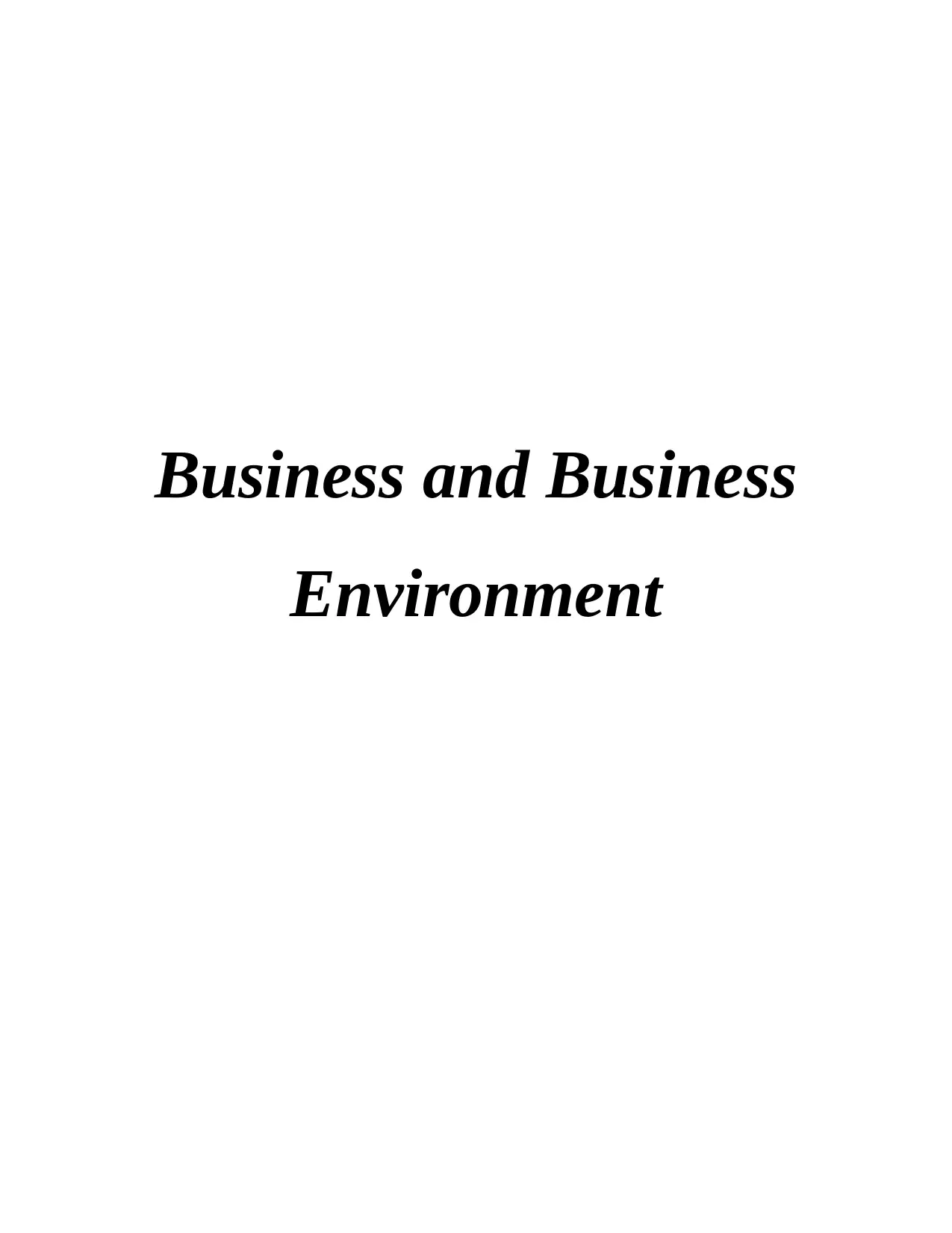
Business and Business
Environment
Environment
Paraphrase This Document
Need a fresh take? Get an instant paraphrase of this document with our AI Paraphraser
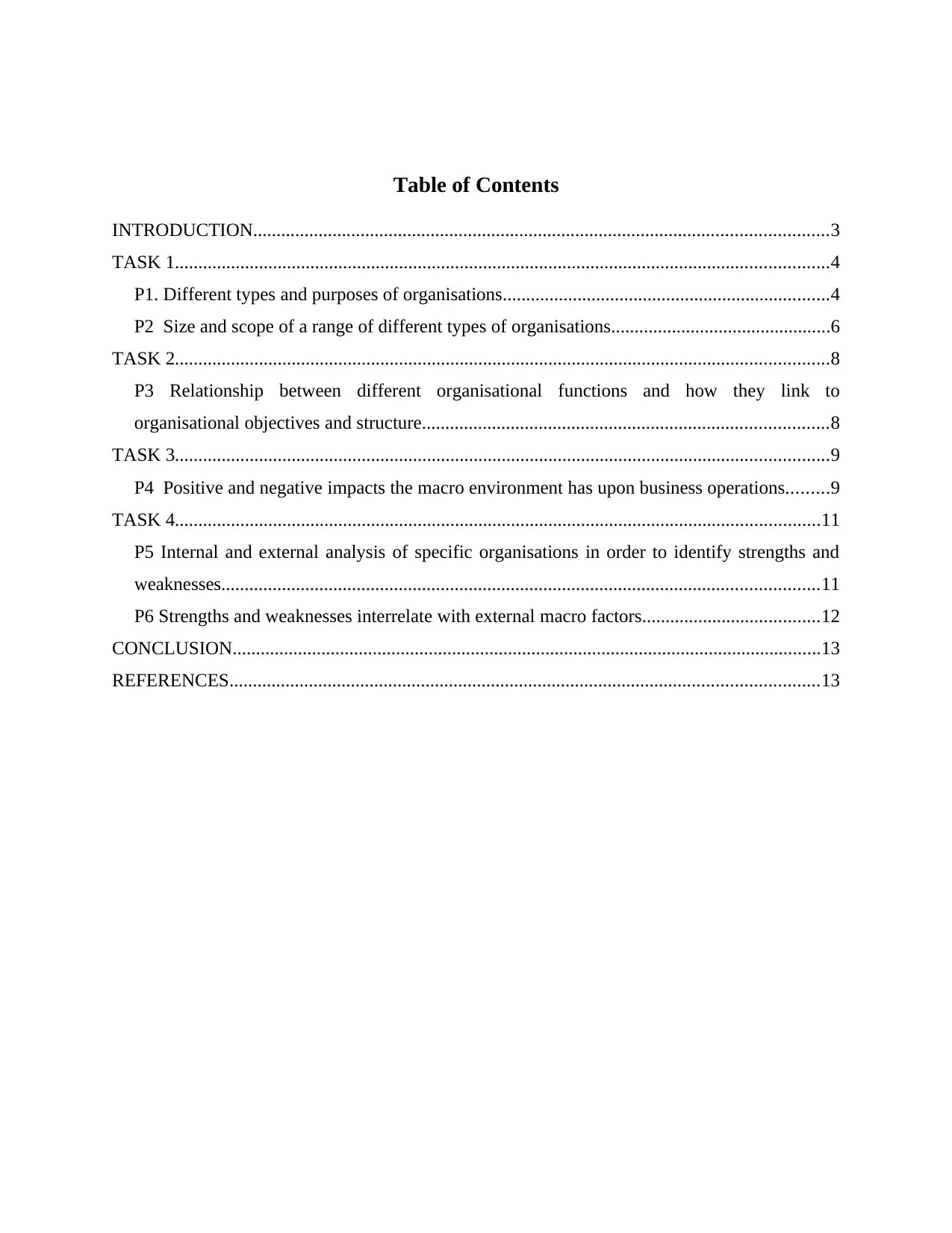
Table of Contents
INTRODUCTION...........................................................................................................................3
TASK 1............................................................................................................................................4
P1. Different types and purposes of organisations......................................................................4
P2 Size and scope of a range of different types of organisations...............................................6
TASK 2............................................................................................................................................8
P3 Relationship between different organisational functions and how they link to
organisational objectives and structure.......................................................................................8
TASK 3............................................................................................................................................9
P4 Positive and negative impacts the macro environment has upon business operations.........9
TASK 4..........................................................................................................................................11
P5 Internal and external analysis of specific organisations in order to identify strengths and
weaknesses................................................................................................................................11
P6 Strengths and weaknesses interrelate with external macro factors......................................12
CONCLUSION..............................................................................................................................13
REFERENCES..............................................................................................................................13
INTRODUCTION...........................................................................................................................3
TASK 1............................................................................................................................................4
P1. Different types and purposes of organisations......................................................................4
P2 Size and scope of a range of different types of organisations...............................................6
TASK 2............................................................................................................................................8
P3 Relationship between different organisational functions and how they link to
organisational objectives and structure.......................................................................................8
TASK 3............................................................................................................................................9
P4 Positive and negative impacts the macro environment has upon business operations.........9
TASK 4..........................................................................................................................................11
P5 Internal and external analysis of specific organisations in order to identify strengths and
weaknesses................................................................................................................................11
P6 Strengths and weaknesses interrelate with external macro factors......................................12
CONCLUSION..............................................................................................................................13
REFERENCES..............................................................................................................................13
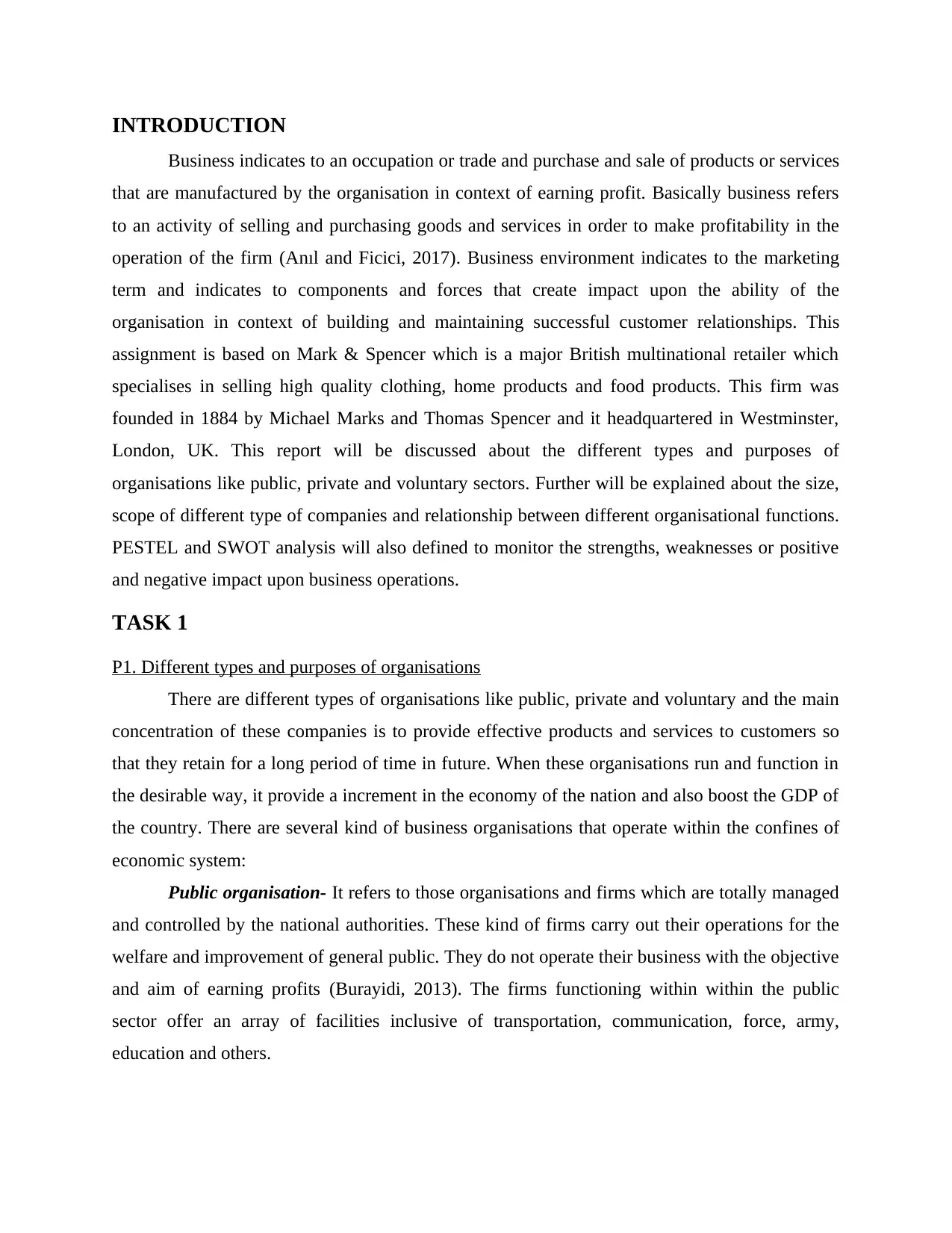
INTRODUCTION
Business indicates to an occupation or trade and purchase and sale of products or services
that are manufactured by the organisation in context of earning profit. Basically business refers
to an activity of selling and purchasing goods and services in order to make profitability in the
operation of the firm (Anıl and Ficici, 2017). Business environment indicates to the marketing
term and indicates to components and forces that create impact upon the ability of the
organisation in context of building and maintaining successful customer relationships. This
assignment is based on Mark & Spencer which is a major British multinational retailer which
specialises in selling high quality clothing, home products and food products. This firm was
founded in 1884 by Michael Marks and Thomas Spencer and it headquartered in Westminster,
London, UK. This report will be discussed about the different types and purposes of
organisations like public, private and voluntary sectors. Further will be explained about the size,
scope of different type of companies and relationship between different organisational functions.
PESTEL and SWOT analysis will also defined to monitor the strengths, weaknesses or positive
and negative impact upon business operations.
TASK 1
P1. Different types and purposes of organisations
There are different types of organisations like public, private and voluntary and the main
concentration of these companies is to provide effective products and services to customers so
that they retain for a long period of time in future. When these organisations run and function in
the desirable way, it provide a increment in the economy of the nation and also boost the GDP of
the country. There are several kind of business organisations that operate within the confines of
economic system:
Public organisation- It refers to those organisations and firms which are totally managed
and controlled by the national authorities. These kind of firms carry out their operations for the
welfare and improvement of general public. They do not operate their business with the objective
and aim of earning profits (Burayidi, 2013). The firms functioning within within the public
sector offer an array of facilities inclusive of transportation, communication, force, army,
education and others.
Business indicates to an occupation or trade and purchase and sale of products or services
that are manufactured by the organisation in context of earning profit. Basically business refers
to an activity of selling and purchasing goods and services in order to make profitability in the
operation of the firm (Anıl and Ficici, 2017). Business environment indicates to the marketing
term and indicates to components and forces that create impact upon the ability of the
organisation in context of building and maintaining successful customer relationships. This
assignment is based on Mark & Spencer which is a major British multinational retailer which
specialises in selling high quality clothing, home products and food products. This firm was
founded in 1884 by Michael Marks and Thomas Spencer and it headquartered in Westminster,
London, UK. This report will be discussed about the different types and purposes of
organisations like public, private and voluntary sectors. Further will be explained about the size,
scope of different type of companies and relationship between different organisational functions.
PESTEL and SWOT analysis will also defined to monitor the strengths, weaknesses or positive
and negative impact upon business operations.
TASK 1
P1. Different types and purposes of organisations
There are different types of organisations like public, private and voluntary and the main
concentration of these companies is to provide effective products and services to customers so
that they retain for a long period of time in future. When these organisations run and function in
the desirable way, it provide a increment in the economy of the nation and also boost the GDP of
the country. There are several kind of business organisations that operate within the confines of
economic system:
Public organisation- It refers to those organisations and firms which are totally managed
and controlled by the national authorities. These kind of firms carry out their operations for the
welfare and improvement of general public. They do not operate their business with the objective
and aim of earning profits (Burayidi, 2013). The firms functioning within within the public
sector offer an array of facilities inclusive of transportation, communication, force, army,
education and others.
⊘ This is a preview!⊘
Do you want full access?
Subscribe today to unlock all pages.

Trusted by 1+ million students worldwide
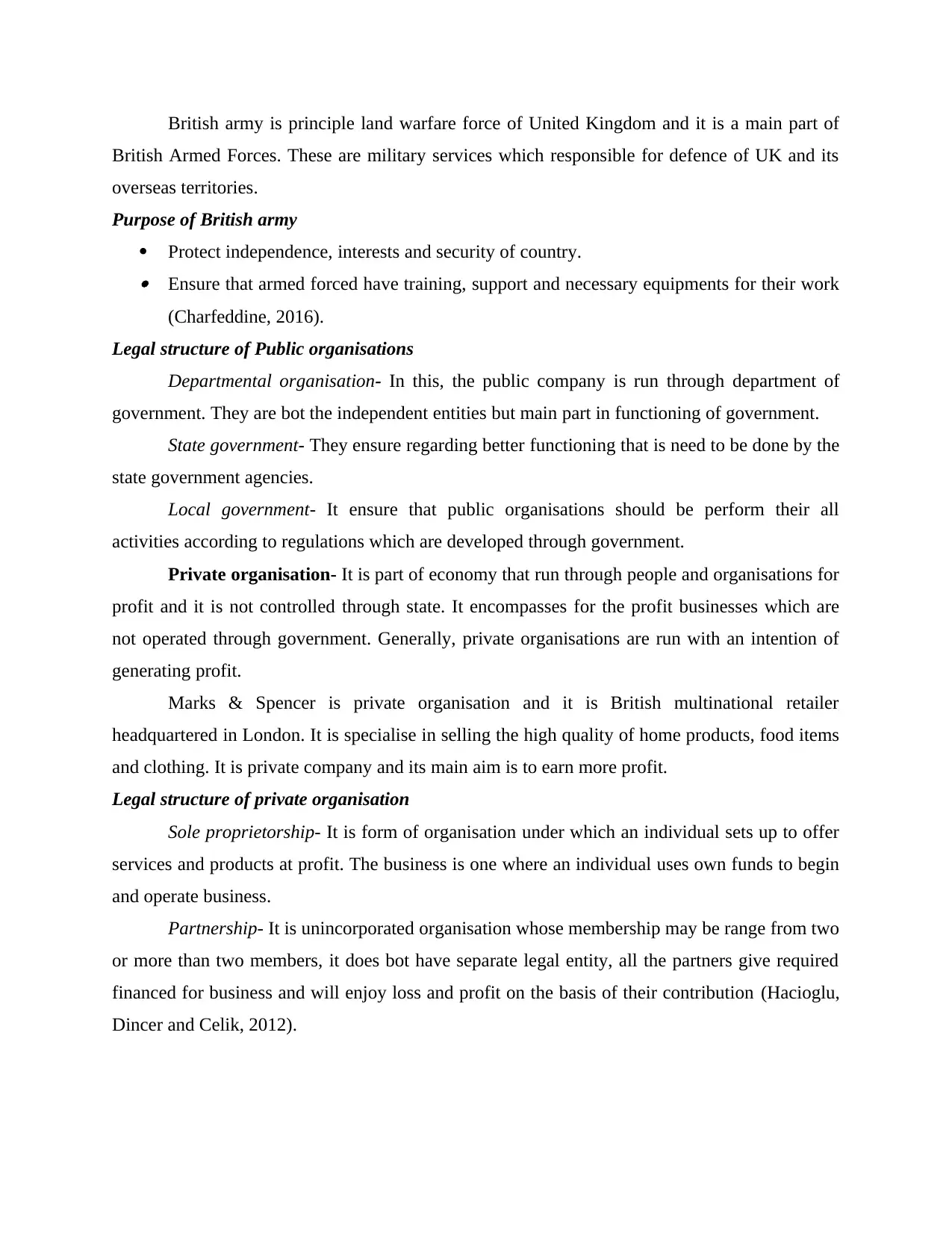
British army is principle land warfare force of United Kingdom and it is a main part of
British Armed Forces. These are military services which responsible for defence of UK and its
overseas territories.
Purpose of British army
Protect independence, interests and security of country. Ensure that armed forced have training, support and necessary equipments for their work
(Charfeddine, 2016).
Legal structure of Public organisations
Departmental organisation- In this, the public company is run through department of
government. They are bot the independent entities but main part in functioning of government.
State government- They ensure regarding better functioning that is need to be done by the
state government agencies.
Local government- It ensure that public organisations should be perform their all
activities according to regulations which are developed through government.
Private organisation- It is part of economy that run through people and organisations for
profit and it is not controlled through state. It encompasses for the profit businesses which are
not operated through government. Generally, private organisations are run with an intention of
generating profit.
Marks & Spencer is private organisation and it is British multinational retailer
headquartered in London. It is specialise in selling the high quality of home products, food items
and clothing. It is private company and its main aim is to earn more profit.
Legal structure of private organisation
Sole proprietorship- It is form of organisation under which an individual sets up to offer
services and products at profit. The business is one where an individual uses own funds to begin
and operate business.
Partnership- It is unincorporated organisation whose membership may be range from two
or more than two members, it does bot have separate legal entity, all the partners give required
financed for business and will enjoy loss and profit on the basis of their contribution (Hacioglu,
Dincer and Celik, 2012).
British Armed Forces. These are military services which responsible for defence of UK and its
overseas territories.
Purpose of British army
Protect independence, interests and security of country. Ensure that armed forced have training, support and necessary equipments for their work
(Charfeddine, 2016).
Legal structure of Public organisations
Departmental organisation- In this, the public company is run through department of
government. They are bot the independent entities but main part in functioning of government.
State government- They ensure regarding better functioning that is need to be done by the
state government agencies.
Local government- It ensure that public organisations should be perform their all
activities according to regulations which are developed through government.
Private organisation- It is part of economy that run through people and organisations for
profit and it is not controlled through state. It encompasses for the profit businesses which are
not operated through government. Generally, private organisations are run with an intention of
generating profit.
Marks & Spencer is private organisation and it is British multinational retailer
headquartered in London. It is specialise in selling the high quality of home products, food items
and clothing. It is private company and its main aim is to earn more profit.
Legal structure of private organisation
Sole proprietorship- It is form of organisation under which an individual sets up to offer
services and products at profit. The business is one where an individual uses own funds to begin
and operate business.
Partnership- It is unincorporated organisation whose membership may be range from two
or more than two members, it does bot have separate legal entity, all the partners give required
financed for business and will enjoy loss and profit on the basis of their contribution (Hacioglu,
Dincer and Celik, 2012).
Paraphrase This Document
Need a fresh take? Get an instant paraphrase of this document with our AI Paraphraser
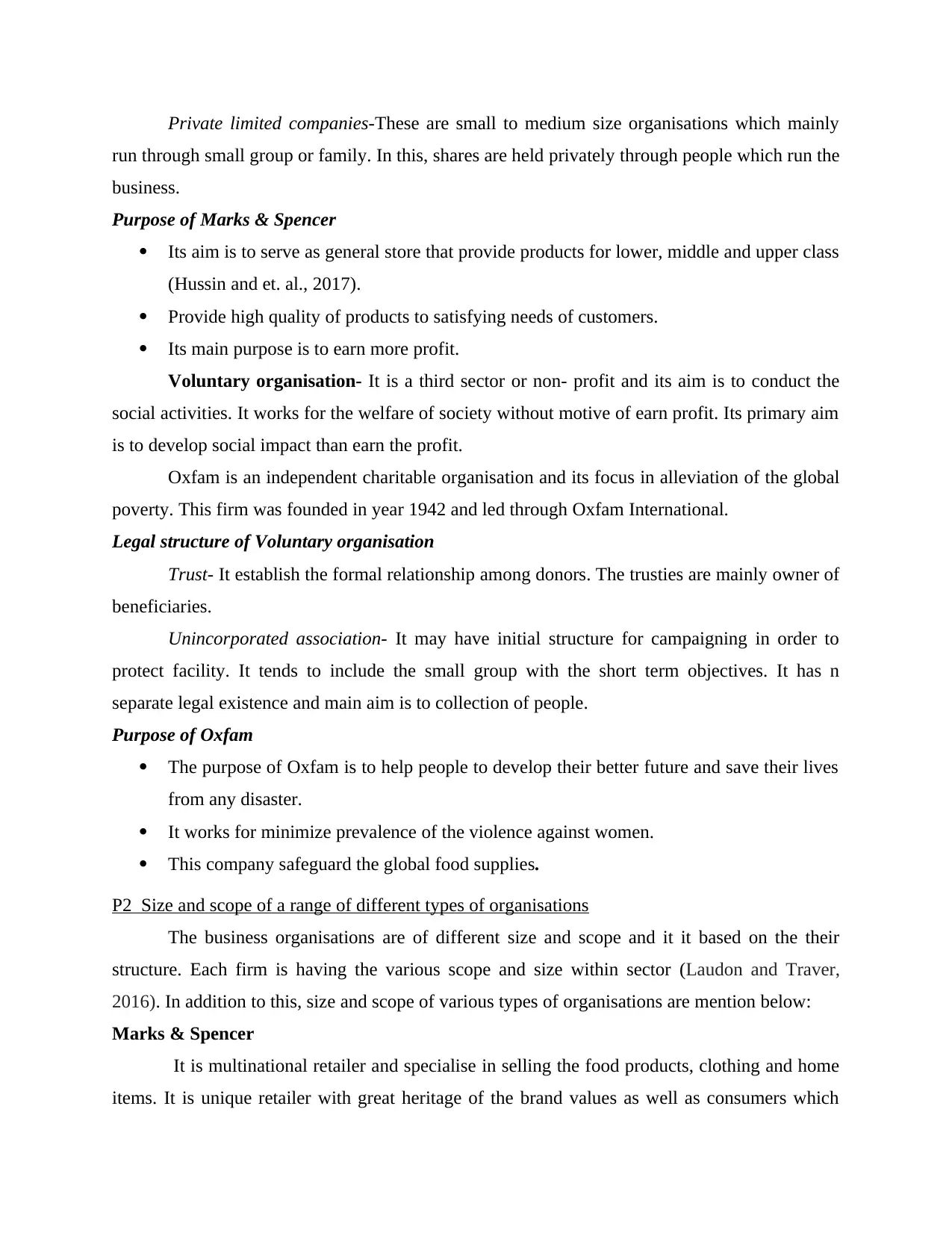
Private limited companies-These are small to medium size organisations which mainly
run through small group or family. In this, shares are held privately through people which run the
business.
Purpose of Marks & Spencer
Its aim is to serve as general store that provide products for lower, middle and upper class
(Hussin and et. al., 2017).
Provide high quality of products to satisfying needs of customers.
Its main purpose is to earn more profit.
Voluntary organisation- It is a third sector or non- profit and its aim is to conduct the
social activities. It works for the welfare of society without motive of earn profit. Its primary aim
is to develop social impact than earn the profit.
Oxfam is an independent charitable organisation and its focus in alleviation of the global
poverty. This firm was founded in year 1942 and led through Oxfam International.
Legal structure of Voluntary organisation
Trust- It establish the formal relationship among donors. The trusties are mainly owner of
beneficiaries.
Unincorporated association- It may have initial structure for campaigning in order to
protect facility. It tends to include the small group with the short term objectives. It has n
separate legal existence and main aim is to collection of people.
Purpose of Oxfam
The purpose of Oxfam is to help people to develop their better future and save their lives
from any disaster.
It works for minimize prevalence of the violence against women.
This company safeguard the global food supplies.
P2 Size and scope of a range of different types of organisations
The business organisations are of different size and scope and it it based on the their
structure. Each firm is having the various scope and size within sector (Laudon and Traver,
2016). In addition to this, size and scope of various types of organisations are mention below:
Marks & Spencer
It is multinational retailer and specialise in selling the food products, clothing and home
items. It is unique retailer with great heritage of the brand values as well as consumers which
run through small group or family. In this, shares are held privately through people which run the
business.
Purpose of Marks & Spencer
Its aim is to serve as general store that provide products for lower, middle and upper class
(Hussin and et. al., 2017).
Provide high quality of products to satisfying needs of customers.
Its main purpose is to earn more profit.
Voluntary organisation- It is a third sector or non- profit and its aim is to conduct the
social activities. It works for the welfare of society without motive of earn profit. Its primary aim
is to develop social impact than earn the profit.
Oxfam is an independent charitable organisation and its focus in alleviation of the global
poverty. This firm was founded in year 1942 and led through Oxfam International.
Legal structure of Voluntary organisation
Trust- It establish the formal relationship among donors. The trusties are mainly owner of
beneficiaries.
Unincorporated association- It may have initial structure for campaigning in order to
protect facility. It tends to include the small group with the short term objectives. It has n
separate legal existence and main aim is to collection of people.
Purpose of Oxfam
The purpose of Oxfam is to help people to develop their better future and save their lives
from any disaster.
It works for minimize prevalence of the violence against women.
This company safeguard the global food supplies.
P2 Size and scope of a range of different types of organisations
The business organisations are of different size and scope and it it based on the their
structure. Each firm is having the various scope and size within sector (Laudon and Traver,
2016). In addition to this, size and scope of various types of organisations are mention below:
Marks & Spencer
It is multinational retailer and specialise in selling the food products, clothing and home
items. It is unique retailer with great heritage of the brand values as well as consumers which
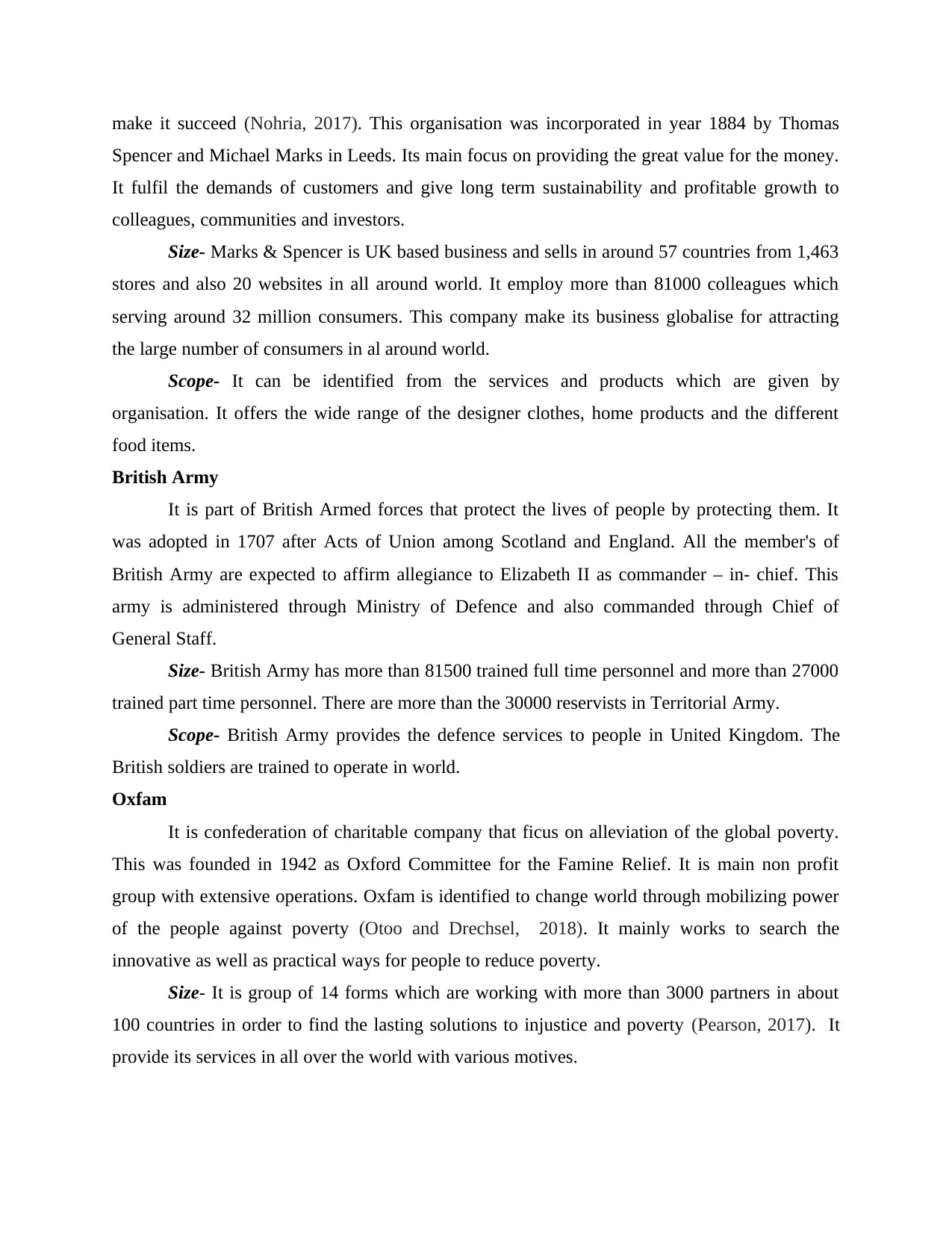
make it succeed (Nohria, 2017). This organisation was incorporated in year 1884 by Thomas
Spencer and Michael Marks in Leeds. Its main focus on providing the great value for the money.
It fulfil the demands of customers and give long term sustainability and profitable growth to
colleagues, communities and investors.
Size- Marks & Spencer is UK based business and sells in around 57 countries from 1,463
stores and also 20 websites in all around world. It employ more than 81000 colleagues which
serving around 32 million consumers. This company make its business globalise for attracting
the large number of consumers in al around world.
Scope- It can be identified from the services and products which are given by
organisation. It offers the wide range of the designer clothes, home products and the different
food items.
British Army
It is part of British Armed forces that protect the lives of people by protecting them. It
was adopted in 1707 after Acts of Union among Scotland and England. All the member's of
British Army are expected to affirm allegiance to Elizabeth II as commander – in- chief. This
army is administered through Ministry of Defence and also commanded through Chief of
General Staff.
Size- British Army has more than 81500 trained full time personnel and more than 27000
trained part time personnel. There are more than the 30000 reservists in Territorial Army.
Scope- British Army provides the defence services to people in United Kingdom. The
British soldiers are trained to operate in world.
Oxfam
It is confederation of charitable company that ficus on alleviation of the global poverty.
This was founded in 1942 as Oxford Committee for the Famine Relief. It is main non profit
group with extensive operations. Oxfam is identified to change world through mobilizing power
of the people against poverty (Otoo and Drechsel, 2018). It mainly works to search the
innovative as well as practical ways for people to reduce poverty.
Size- It is group of 14 forms which are working with more than 3000 partners in about
100 countries in order to find the lasting solutions to injustice and poverty (Pearson, 2017). It
provide its services in all over the world with various motives.
Spencer and Michael Marks in Leeds. Its main focus on providing the great value for the money.
It fulfil the demands of customers and give long term sustainability and profitable growth to
colleagues, communities and investors.
Size- Marks & Spencer is UK based business and sells in around 57 countries from 1,463
stores and also 20 websites in all around world. It employ more than 81000 colleagues which
serving around 32 million consumers. This company make its business globalise for attracting
the large number of consumers in al around world.
Scope- It can be identified from the services and products which are given by
organisation. It offers the wide range of the designer clothes, home products and the different
food items.
British Army
It is part of British Armed forces that protect the lives of people by protecting them. It
was adopted in 1707 after Acts of Union among Scotland and England. All the member's of
British Army are expected to affirm allegiance to Elizabeth II as commander – in- chief. This
army is administered through Ministry of Defence and also commanded through Chief of
General Staff.
Size- British Army has more than 81500 trained full time personnel and more than 27000
trained part time personnel. There are more than the 30000 reservists in Territorial Army.
Scope- British Army provides the defence services to people in United Kingdom. The
British soldiers are trained to operate in world.
Oxfam
It is confederation of charitable company that ficus on alleviation of the global poverty.
This was founded in 1942 as Oxford Committee for the Famine Relief. It is main non profit
group with extensive operations. Oxfam is identified to change world through mobilizing power
of the people against poverty (Otoo and Drechsel, 2018). It mainly works to search the
innovative as well as practical ways for people to reduce poverty.
Size- It is group of 14 forms which are working with more than 3000 partners in about
100 countries in order to find the lasting solutions to injustice and poverty (Pearson, 2017). It
provide its services in all over the world with various motives.
⊘ This is a preview!⊘
Do you want full access?
Subscribe today to unlock all pages.

Trusted by 1+ million students worldwide
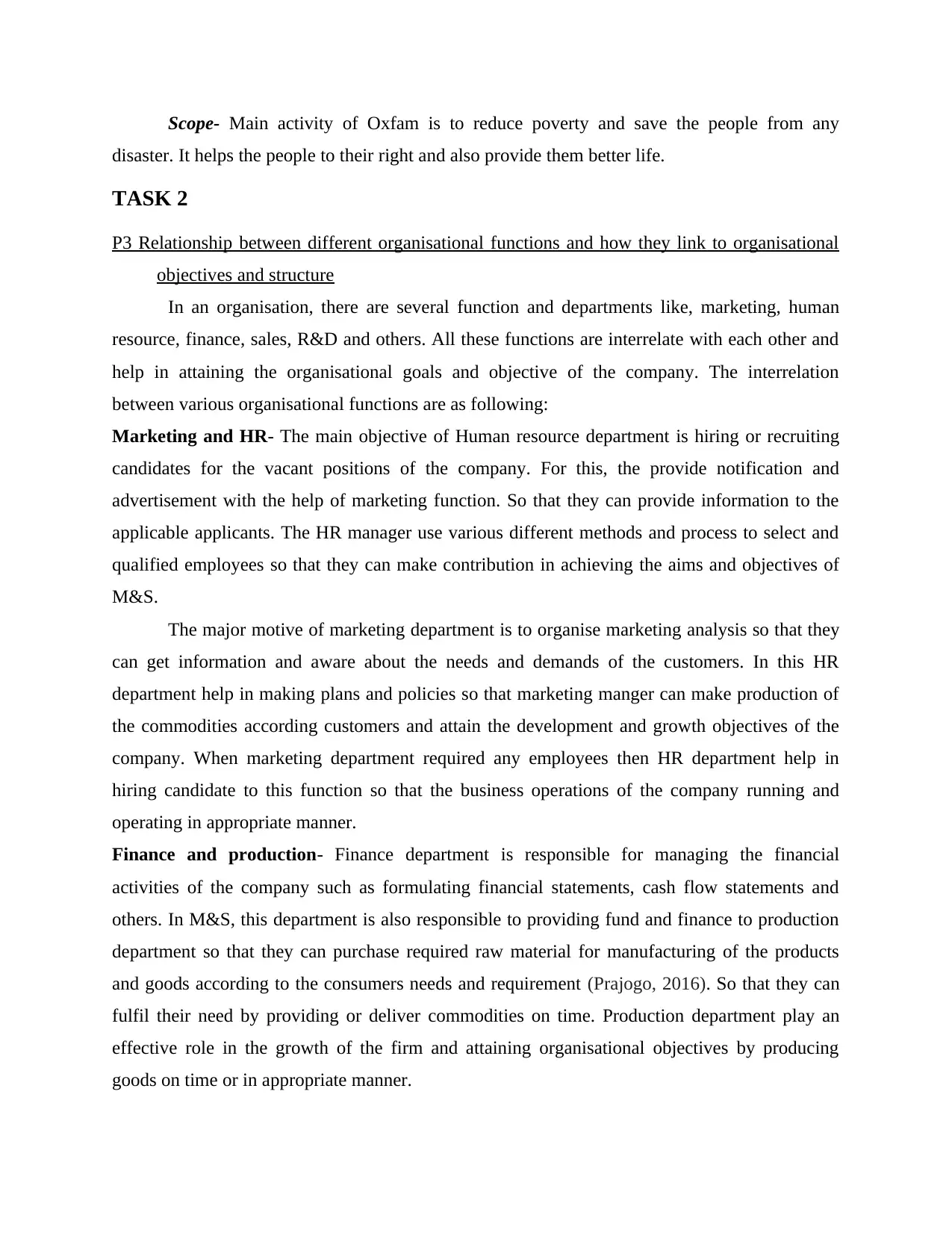
Scope- Main activity of Oxfam is to reduce poverty and save the people from any
disaster. It helps the people to their right and also provide them better life.
TASK 2
P3 Relationship between different organisational functions and how they link to organisational
objectives and structure
In an organisation, there are several function and departments like, marketing, human
resource, finance, sales, R&D and others. All these functions are interrelate with each other and
help in attaining the organisational goals and objective of the company. The interrelation
between various organisational functions are as following:
Marketing and HR- The main objective of Human resource department is hiring or recruiting
candidates for the vacant positions of the company. For this, the provide notification and
advertisement with the help of marketing function. So that they can provide information to the
applicable applicants. The HR manager use various different methods and process to select and
qualified employees so that they can make contribution in achieving the aims and objectives of
M&S.
The major motive of marketing department is to organise marketing analysis so that they
can get information and aware about the needs and demands of the customers. In this HR
department help in making plans and policies so that marketing manger can make production of
the commodities according customers and attain the development and growth objectives of the
company. When marketing department required any employees then HR department help in
hiring candidate to this function so that the business operations of the company running and
operating in appropriate manner.
Finance and production- Finance department is responsible for managing the financial
activities of the company such as formulating financial statements, cash flow statements and
others. In M&S, this department is also responsible to providing fund and finance to production
department so that they can purchase required raw material for manufacturing of the products
and goods according to the consumers needs and requirement (Prajogo, 2016). So that they can
fulfil their need by providing or deliver commodities on time. Production department play an
effective role in the growth of the firm and attaining organisational objectives by producing
goods on time or in appropriate manner.
disaster. It helps the people to their right and also provide them better life.
TASK 2
P3 Relationship between different organisational functions and how they link to organisational
objectives and structure
In an organisation, there are several function and departments like, marketing, human
resource, finance, sales, R&D and others. All these functions are interrelate with each other and
help in attaining the organisational goals and objective of the company. The interrelation
between various organisational functions are as following:
Marketing and HR- The main objective of Human resource department is hiring or recruiting
candidates for the vacant positions of the company. For this, the provide notification and
advertisement with the help of marketing function. So that they can provide information to the
applicable applicants. The HR manager use various different methods and process to select and
qualified employees so that they can make contribution in achieving the aims and objectives of
M&S.
The major motive of marketing department is to organise marketing analysis so that they
can get information and aware about the needs and demands of the customers. In this HR
department help in making plans and policies so that marketing manger can make production of
the commodities according customers and attain the development and growth objectives of the
company. When marketing department required any employees then HR department help in
hiring candidate to this function so that the business operations of the company running and
operating in appropriate manner.
Finance and production- Finance department is responsible for managing the financial
activities of the company such as formulating financial statements, cash flow statements and
others. In M&S, this department is also responsible to providing fund and finance to production
department so that they can purchase required raw material for manufacturing of the products
and goods according to the consumers needs and requirement (Prajogo, 2016). So that they can
fulfil their need by providing or deliver commodities on time. Production department play an
effective role in the growth of the firm and attaining organisational objectives by producing
goods on time or in appropriate manner.
Paraphrase This Document
Need a fresh take? Get an instant paraphrase of this document with our AI Paraphraser
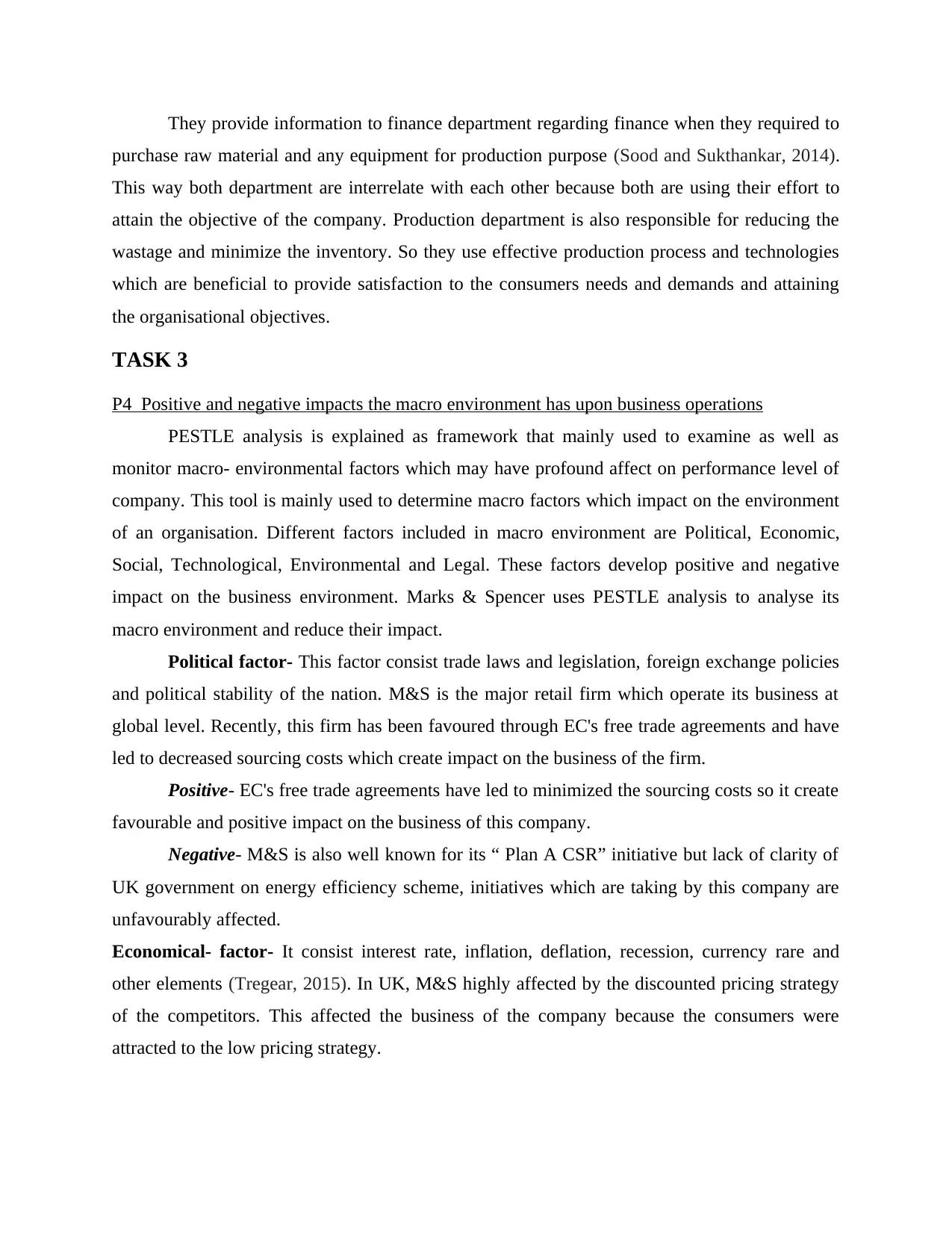
They provide information to finance department regarding finance when they required to
purchase raw material and any equipment for production purpose (Sood and Sukthankar, 2014).
This way both department are interrelate with each other because both are using their effort to
attain the objective of the company. Production department is also responsible for reducing the
wastage and minimize the inventory. So they use effective production process and technologies
which are beneficial to provide satisfaction to the consumers needs and demands and attaining
the organisational objectives.
TASK 3
P4 Positive and negative impacts the macro environment has upon business operations
PESTLE analysis is explained as framework that mainly used to examine as well as
monitor macro- environmental factors which may have profound affect on performance level of
company. This tool is mainly used to determine macro factors which impact on the environment
of an organisation. Different factors included in macro environment are Political, Economic,
Social, Technological, Environmental and Legal. These factors develop positive and negative
impact on the business environment. Marks & Spencer uses PESTLE analysis to analyse its
macro environment and reduce their impact.
Political factor- This factor consist trade laws and legislation, foreign exchange policies
and political stability of the nation. M&S is the major retail firm which operate its business at
global level. Recently, this firm has been favoured through EC's free trade agreements and have
led to decreased sourcing costs which create impact on the business of the firm.
Positive- EC's free trade agreements have led to minimized the sourcing costs so it create
favourable and positive impact on the business of this company.
Negative- M&S is also well known for its “ Plan A CSR” initiative but lack of clarity of
UK government on energy efficiency scheme, initiatives which are taking by this company are
unfavourably affected.
Economical- factor- It consist interest rate, inflation, deflation, recession, currency rare and
other elements (Tregear, 2015). In UK, M&S highly affected by the discounted pricing strategy
of the competitors. This affected the business of the company because the consumers were
attracted to the low pricing strategy.
purchase raw material and any equipment for production purpose (Sood and Sukthankar, 2014).
This way both department are interrelate with each other because both are using their effort to
attain the objective of the company. Production department is also responsible for reducing the
wastage and minimize the inventory. So they use effective production process and technologies
which are beneficial to provide satisfaction to the consumers needs and demands and attaining
the organisational objectives.
TASK 3
P4 Positive and negative impacts the macro environment has upon business operations
PESTLE analysis is explained as framework that mainly used to examine as well as
monitor macro- environmental factors which may have profound affect on performance level of
company. This tool is mainly used to determine macro factors which impact on the environment
of an organisation. Different factors included in macro environment are Political, Economic,
Social, Technological, Environmental and Legal. These factors develop positive and negative
impact on the business environment. Marks & Spencer uses PESTLE analysis to analyse its
macro environment and reduce their impact.
Political factor- This factor consist trade laws and legislation, foreign exchange policies
and political stability of the nation. M&S is the major retail firm which operate its business at
global level. Recently, this firm has been favoured through EC's free trade agreements and have
led to decreased sourcing costs which create impact on the business of the firm.
Positive- EC's free trade agreements have led to minimized the sourcing costs so it create
favourable and positive impact on the business of this company.
Negative- M&S is also well known for its “ Plan A CSR” initiative but lack of clarity of
UK government on energy efficiency scheme, initiatives which are taking by this company are
unfavourably affected.
Economical- factor- It consist interest rate, inflation, deflation, recession, currency rare and
other elements (Tregear, 2015). In UK, M&S highly affected by the discounted pricing strategy
of the competitors. This affected the business of the company because the consumers were
attracted to the low pricing strategy.
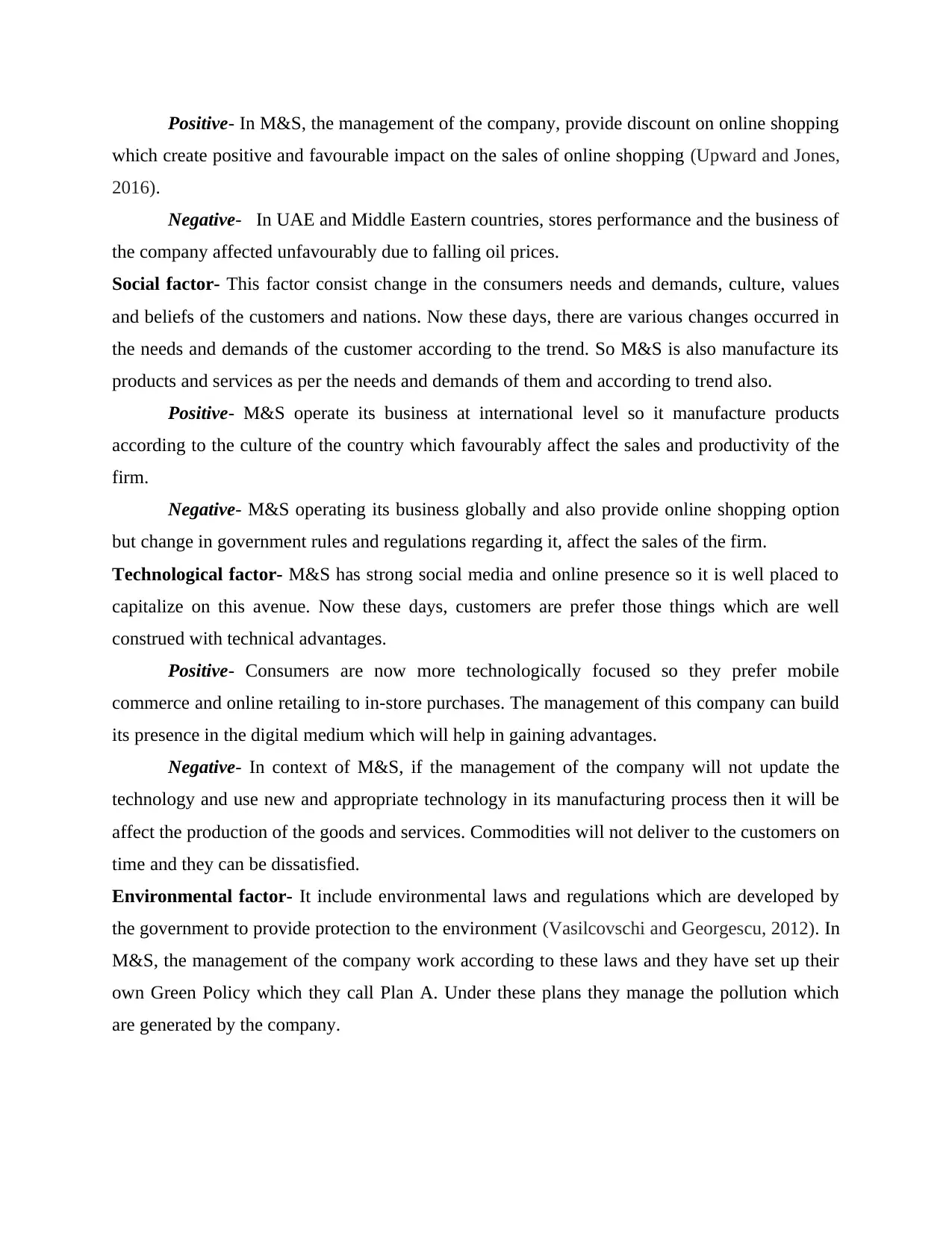
Positive- In M&S, the management of the company, provide discount on online shopping
which create positive and favourable impact on the sales of online shopping (Upward and Jones,
2016).
Negative- In UAE and Middle Eastern countries, stores performance and the business of
the company affected unfavourably due to falling oil prices.
Social factor- This factor consist change in the consumers needs and demands, culture, values
and beliefs of the customers and nations. Now these days, there are various changes occurred in
the needs and demands of the customer according to the trend. So M&S is also manufacture its
products and services as per the needs and demands of them and according to trend also.
Positive- M&S operate its business at international level so it manufacture products
according to the culture of the country which favourably affect the sales and productivity of the
firm.
Negative- M&S operating its business globally and also provide online shopping option
but change in government rules and regulations regarding it, affect the sales of the firm.
Technological factor- M&S has strong social media and online presence so it is well placed to
capitalize on this avenue. Now these days, customers are prefer those things which are well
construed with technical advantages.
Positive- Consumers are now more technologically focused so they prefer mobile
commerce and online retailing to in-store purchases. The management of this company can build
its presence in the digital medium which will help in gaining advantages.
Negative- In context of M&S, if the management of the company will not update the
technology and use new and appropriate technology in its manufacturing process then it will be
affect the production of the goods and services. Commodities will not deliver to the customers on
time and they can be dissatisfied.
Environmental factor- It include environmental laws and regulations which are developed by
the government to provide protection to the environment (Vasilcovschi and Georgescu, 2012). In
M&S, the management of the company work according to these laws and they have set up their
own Green Policy which they call Plan A. Under these plans they manage the pollution which
are generated by the company.
which create positive and favourable impact on the sales of online shopping (Upward and Jones,
2016).
Negative- In UAE and Middle Eastern countries, stores performance and the business of
the company affected unfavourably due to falling oil prices.
Social factor- This factor consist change in the consumers needs and demands, culture, values
and beliefs of the customers and nations. Now these days, there are various changes occurred in
the needs and demands of the customer according to the trend. So M&S is also manufacture its
products and services as per the needs and demands of them and according to trend also.
Positive- M&S operate its business at international level so it manufacture products
according to the culture of the country which favourably affect the sales and productivity of the
firm.
Negative- M&S operating its business globally and also provide online shopping option
but change in government rules and regulations regarding it, affect the sales of the firm.
Technological factor- M&S has strong social media and online presence so it is well placed to
capitalize on this avenue. Now these days, customers are prefer those things which are well
construed with technical advantages.
Positive- Consumers are now more technologically focused so they prefer mobile
commerce and online retailing to in-store purchases. The management of this company can build
its presence in the digital medium which will help in gaining advantages.
Negative- In context of M&S, if the management of the company will not update the
technology and use new and appropriate technology in its manufacturing process then it will be
affect the production of the goods and services. Commodities will not deliver to the customers on
time and they can be dissatisfied.
Environmental factor- It include environmental laws and regulations which are developed by
the government to provide protection to the environment (Vasilcovschi and Georgescu, 2012). In
M&S, the management of the company work according to these laws and they have set up their
own Green Policy which they call Plan A. Under these plans they manage the pollution which
are generated by the company.
⊘ This is a preview!⊘
Do you want full access?
Subscribe today to unlock all pages.

Trusted by 1+ million students worldwide
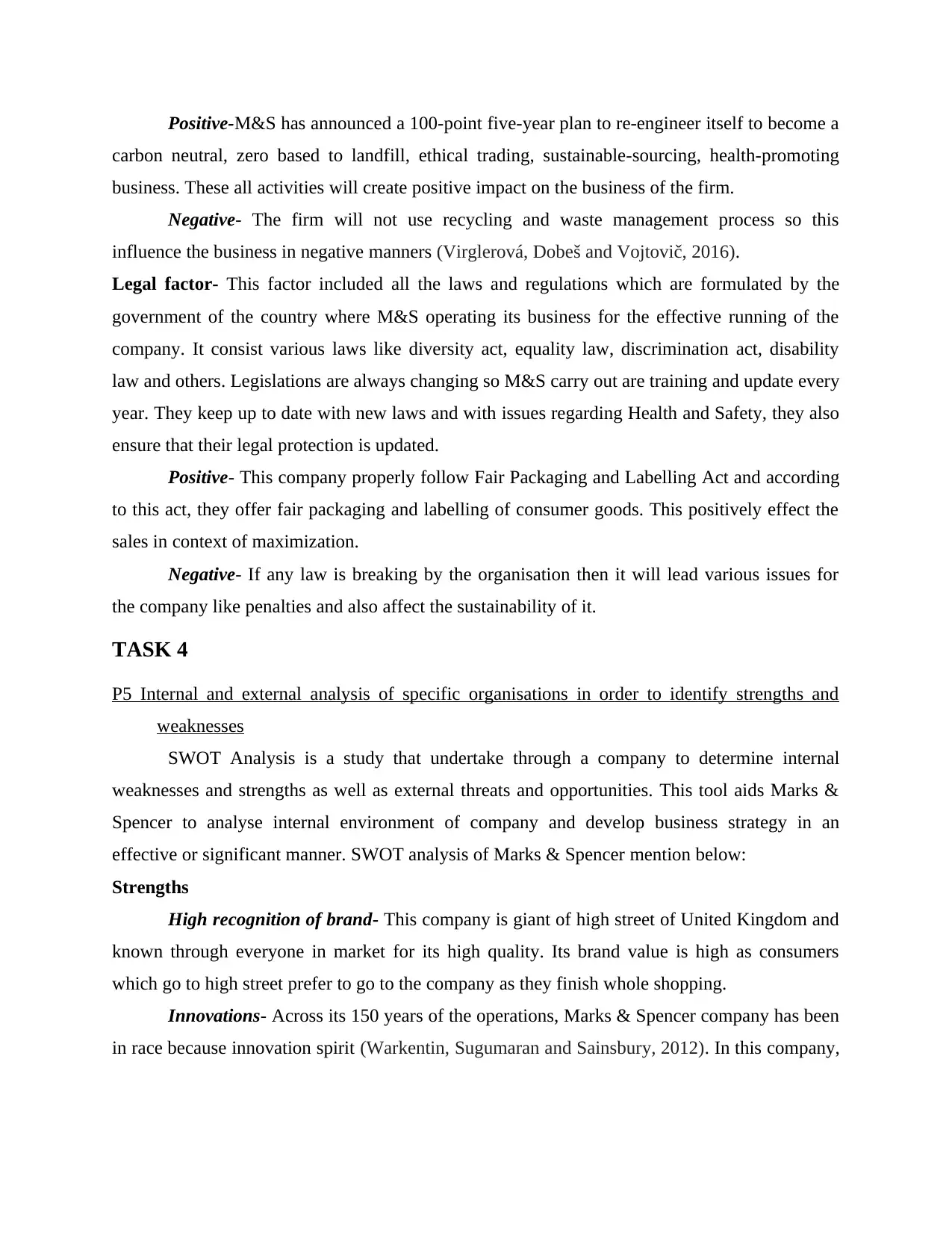
Positive-M&S has announced a 100-point five-year plan to re-engineer itself to become a
carbon neutral, zero based to landfill, ethical trading, sustainable-sourcing, health-promoting
business. These all activities will create positive impact on the business of the firm.
Negative- The firm will not use recycling and waste management process so this
influence the business in negative manners (Virglerová, Dobeš and Vojtovič, 2016).
Legal factor- This factor included all the laws and regulations which are formulated by the
government of the country where M&S operating its business for the effective running of the
company. It consist various laws like diversity act, equality law, discrimination act, disability
law and others. Legislations are always changing so M&S carry out are training and update every
year. They keep up to date with new laws and with issues regarding Health and Safety, they also
ensure that their legal protection is updated.
Positive- This company properly follow Fair Packaging and Labelling Act and according
to this act, they offer fair packaging and labelling of consumer goods. This positively effect the
sales in context of maximization.
Negative- If any law is breaking by the organisation then it will lead various issues for
the company like penalties and also affect the sustainability of it.
TASK 4
P5 Internal and external analysis of specific organisations in order to identify strengths and
weaknesses
SWOT Analysis is a study that undertake through a company to determine internal
weaknesses and strengths as well as external threats and opportunities. This tool aids Marks &
Spencer to analyse internal environment of company and develop business strategy in an
effective or significant manner. SWOT analysis of Marks & Spencer mention below:
Strengths
High recognition of brand- This company is giant of high street of United Kingdom and
known through everyone in market for its high quality. Its brand value is high as consumers
which go to high street prefer to go to the company as they finish whole shopping.
Innovations- Across its 150 years of the operations, Marks & Spencer company has been
in race because innovation spirit (Warkentin, Sugumaran and Sainsbury, 2012). In this company,
carbon neutral, zero based to landfill, ethical trading, sustainable-sourcing, health-promoting
business. These all activities will create positive impact on the business of the firm.
Negative- The firm will not use recycling and waste management process so this
influence the business in negative manners (Virglerová, Dobeš and Vojtovič, 2016).
Legal factor- This factor included all the laws and regulations which are formulated by the
government of the country where M&S operating its business for the effective running of the
company. It consist various laws like diversity act, equality law, discrimination act, disability
law and others. Legislations are always changing so M&S carry out are training and update every
year. They keep up to date with new laws and with issues regarding Health and Safety, they also
ensure that their legal protection is updated.
Positive- This company properly follow Fair Packaging and Labelling Act and according
to this act, they offer fair packaging and labelling of consumer goods. This positively effect the
sales in context of maximization.
Negative- If any law is breaking by the organisation then it will lead various issues for
the company like penalties and also affect the sustainability of it.
TASK 4
P5 Internal and external analysis of specific organisations in order to identify strengths and
weaknesses
SWOT Analysis is a study that undertake through a company to determine internal
weaknesses and strengths as well as external threats and opportunities. This tool aids Marks &
Spencer to analyse internal environment of company and develop business strategy in an
effective or significant manner. SWOT analysis of Marks & Spencer mention below:
Strengths
High recognition of brand- This company is giant of high street of United Kingdom and
known through everyone in market for its high quality. Its brand value is high as consumers
which go to high street prefer to go to the company as they finish whole shopping.
Innovations- Across its 150 years of the operations, Marks & Spencer company has been
in race because innovation spirit (Warkentin, Sugumaran and Sainsbury, 2012). In this company,
Paraphrase This Document
Need a fresh take? Get an instant paraphrase of this document with our AI Paraphraser
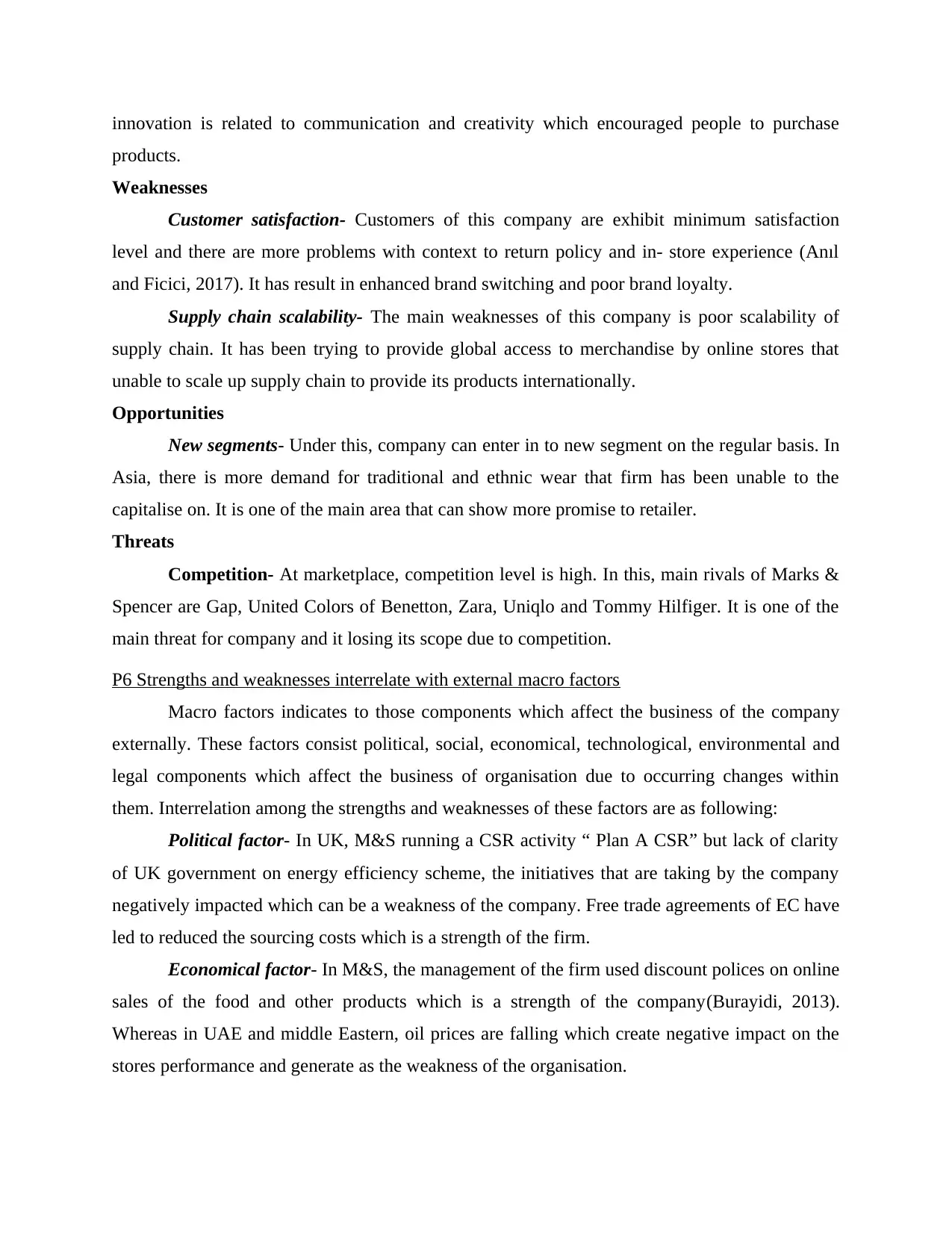
innovation is related to communication and creativity which encouraged people to purchase
products.
Weaknesses
Customer satisfaction- Customers of this company are exhibit minimum satisfaction
level and there are more problems with context to return policy and in- store experience (Anıl
and Ficici, 2017). It has result in enhanced brand switching and poor brand loyalty.
Supply chain scalability- The main weaknesses of this company is poor scalability of
supply chain. It has been trying to provide global access to merchandise by online stores that
unable to scale up supply chain to provide its products internationally.
Opportunities
New segments- Under this, company can enter in to new segment on the regular basis. In
Asia, there is more demand for traditional and ethnic wear that firm has been unable to the
capitalise on. It is one of the main area that can show more promise to retailer.
Threats
Competition- At marketplace, competition level is high. In this, main rivals of Marks &
Spencer are Gap, United Colors of Benetton, Zara, Uniqlo and Tommy Hilfiger. It is one of the
main threat for company and it losing its scope due to competition.
P6 Strengths and weaknesses interrelate with external macro factors
Macro factors indicates to those components which affect the business of the company
externally. These factors consist political, social, economical, technological, environmental and
legal components which affect the business of organisation due to occurring changes within
them. Interrelation among the strengths and weaknesses of these factors are as following:
Political factor- In UK, M&S running a CSR activity “ Plan A CSR” but lack of clarity
of UK government on energy efficiency scheme, the initiatives that are taking by the company
negatively impacted which can be a weakness of the company. Free trade agreements of EC have
led to reduced the sourcing costs which is a strength of the firm.
Economical factor- In M&S, the management of the firm used discount polices on online
sales of the food and other products which is a strength of the company(Burayidi, 2013).
Whereas in UAE and middle Eastern, oil prices are falling which create negative impact on the
stores performance and generate as the weakness of the organisation.
products.
Weaknesses
Customer satisfaction- Customers of this company are exhibit minimum satisfaction
level and there are more problems with context to return policy and in- store experience (Anıl
and Ficici, 2017). It has result in enhanced brand switching and poor brand loyalty.
Supply chain scalability- The main weaknesses of this company is poor scalability of
supply chain. It has been trying to provide global access to merchandise by online stores that
unable to scale up supply chain to provide its products internationally.
Opportunities
New segments- Under this, company can enter in to new segment on the regular basis. In
Asia, there is more demand for traditional and ethnic wear that firm has been unable to the
capitalise on. It is one of the main area that can show more promise to retailer.
Threats
Competition- At marketplace, competition level is high. In this, main rivals of Marks &
Spencer are Gap, United Colors of Benetton, Zara, Uniqlo and Tommy Hilfiger. It is one of the
main threat for company and it losing its scope due to competition.
P6 Strengths and weaknesses interrelate with external macro factors
Macro factors indicates to those components which affect the business of the company
externally. These factors consist political, social, economical, technological, environmental and
legal components which affect the business of organisation due to occurring changes within
them. Interrelation among the strengths and weaknesses of these factors are as following:
Political factor- In UK, M&S running a CSR activity “ Plan A CSR” but lack of clarity
of UK government on energy efficiency scheme, the initiatives that are taking by the company
negatively impacted which can be a weakness of the company. Free trade agreements of EC have
led to reduced the sourcing costs which is a strength of the firm.
Economical factor- In M&S, the management of the firm used discount polices on online
sales of the food and other products which is a strength of the company(Burayidi, 2013).
Whereas in UAE and middle Eastern, oil prices are falling which create negative impact on the
stores performance and generate as the weakness of the organisation.
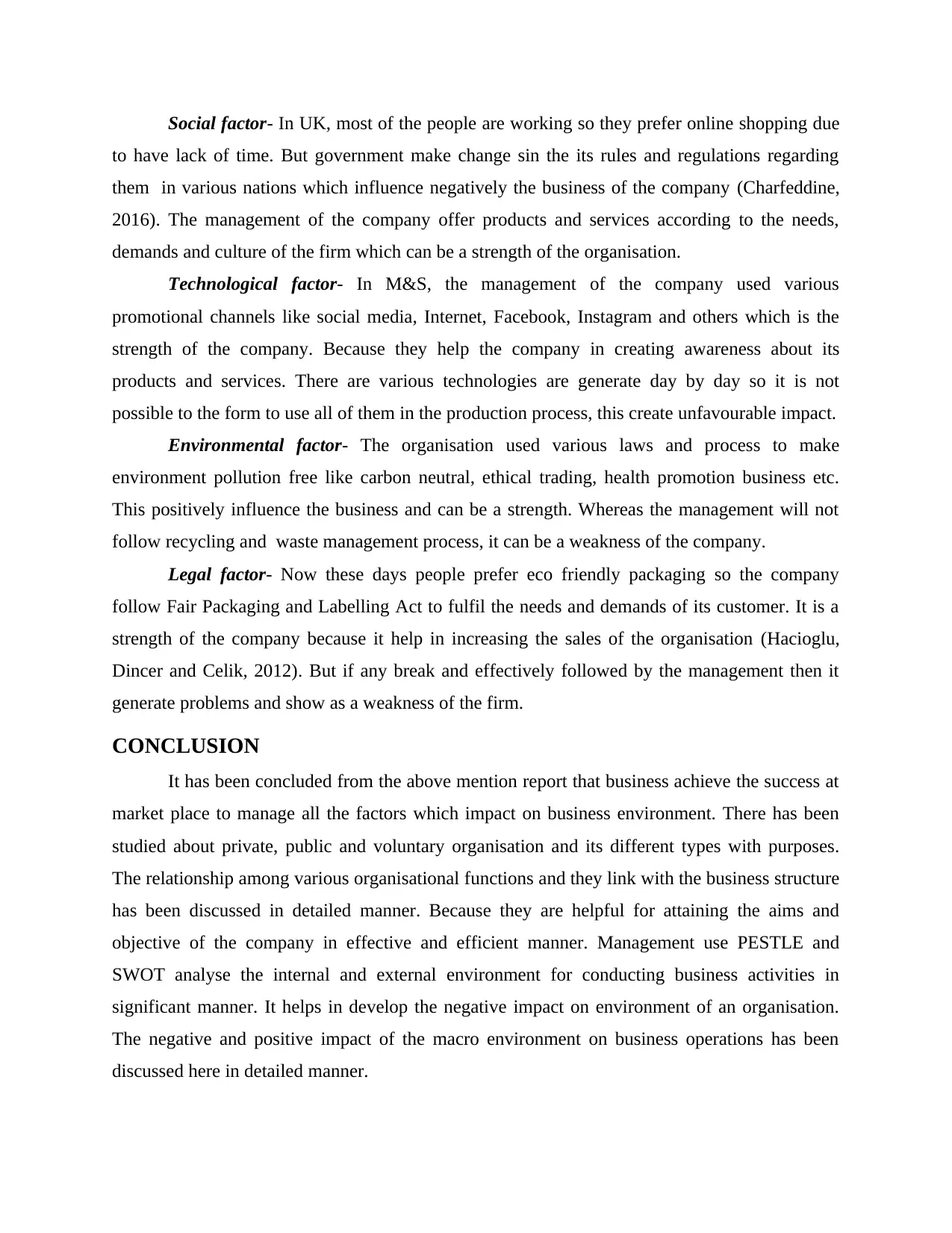
Social factor- In UK, most of the people are working so they prefer online shopping due
to have lack of time. But government make change sin the its rules and regulations regarding
them in various nations which influence negatively the business of the company (Charfeddine,
2016). The management of the company offer products and services according to the needs,
demands and culture of the firm which can be a strength of the organisation.
Technological factor- In M&S, the management of the company used various
promotional channels like social media, Internet, Facebook, Instagram and others which is the
strength of the company. Because they help the company in creating awareness about its
products and services. There are various technologies are generate day by day so it is not
possible to the form to use all of them in the production process, this create unfavourable impact.
Environmental factor- The organisation used various laws and process to make
environment pollution free like carbon neutral, ethical trading, health promotion business etc.
This positively influence the business and can be a strength. Whereas the management will not
follow recycling and waste management process, it can be a weakness of the company.
Legal factor- Now these days people prefer eco friendly packaging so the company
follow Fair Packaging and Labelling Act to fulfil the needs and demands of its customer. It is a
strength of the company because it help in increasing the sales of the organisation (Hacioglu,
Dincer and Celik, 2012). But if any break and effectively followed by the management then it
generate problems and show as a weakness of the firm.
CONCLUSION
It has been concluded from the above mention report that business achieve the success at
market place to manage all the factors which impact on business environment. There has been
studied about private, public and voluntary organisation and its different types with purposes.
The relationship among various organisational functions and they link with the business structure
has been discussed in detailed manner. Because they are helpful for attaining the aims and
objective of the company in effective and efficient manner. Management use PESTLE and
SWOT analyse the internal and external environment for conducting business activities in
significant manner. It helps in develop the negative impact on environment of an organisation.
The negative and positive impact of the macro environment on business operations has been
discussed here in detailed manner.
to have lack of time. But government make change sin the its rules and regulations regarding
them in various nations which influence negatively the business of the company (Charfeddine,
2016). The management of the company offer products and services according to the needs,
demands and culture of the firm which can be a strength of the organisation.
Technological factor- In M&S, the management of the company used various
promotional channels like social media, Internet, Facebook, Instagram and others which is the
strength of the company. Because they help the company in creating awareness about its
products and services. There are various technologies are generate day by day so it is not
possible to the form to use all of them in the production process, this create unfavourable impact.
Environmental factor- The organisation used various laws and process to make
environment pollution free like carbon neutral, ethical trading, health promotion business etc.
This positively influence the business and can be a strength. Whereas the management will not
follow recycling and waste management process, it can be a weakness of the company.
Legal factor- Now these days people prefer eco friendly packaging so the company
follow Fair Packaging and Labelling Act to fulfil the needs and demands of its customer. It is a
strength of the company because it help in increasing the sales of the organisation (Hacioglu,
Dincer and Celik, 2012). But if any break and effectively followed by the management then it
generate problems and show as a weakness of the firm.
CONCLUSION
It has been concluded from the above mention report that business achieve the success at
market place to manage all the factors which impact on business environment. There has been
studied about private, public and voluntary organisation and its different types with purposes.
The relationship among various organisational functions and they link with the business structure
has been discussed in detailed manner. Because they are helpful for attaining the aims and
objective of the company in effective and efficient manner. Management use PESTLE and
SWOT analyse the internal and external environment for conducting business activities in
significant manner. It helps in develop the negative impact on environment of an organisation.
The negative and positive impact of the macro environment on business operations has been
discussed here in detailed manner.
⊘ This is a preview!⊘
Do you want full access?
Subscribe today to unlock all pages.

Trusted by 1+ million students worldwide
1 out of 14
Related Documents
Your All-in-One AI-Powered Toolkit for Academic Success.
+13062052269
info@desklib.com
Available 24*7 on WhatsApp / Email
![[object Object]](/_next/static/media/star-bottom.7253800d.svg)
Unlock your academic potential
Copyright © 2020–2025 A2Z Services. All Rights Reserved. Developed and managed by ZUCOL.





